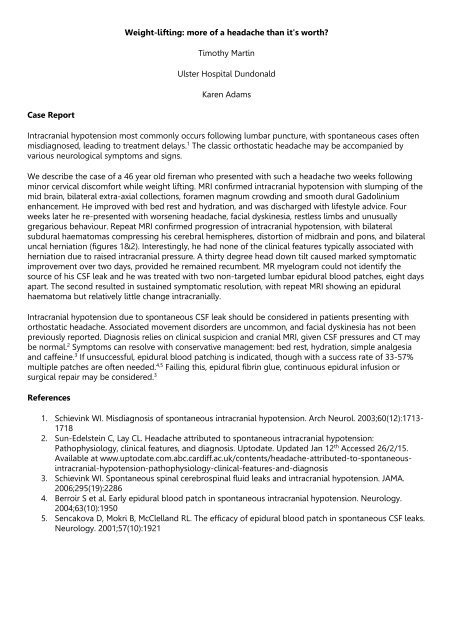Case Report ABSTRACTS
Case-Report-Abstracts
Case-Report-Abstracts
Create successful ePaper yourself
Turn your PDF publications into a flip-book with our unique Google optimized e-Paper software.
Weight-lifting: more of a headache than it's worth?<br />
Timothy Martin<br />
Ulster Hospital Dundonald<br />
Karen Adams<br />
<strong>Case</strong> <strong>Report</strong><br />
Intracranial hypotension most commonly occurs following lumbar puncture, with spontaneous cases often<br />
misdiagnosed, leading to treatment delays. 1 The classic orthostatic headache may be accompanied by<br />
various neurological symptoms and signs.<br />
We describe the case of a 46 year old fireman who presented with such a headache two weeks following<br />
minor cervical discomfort while weight lifting. MRI confirmed intracranial hypotension with slumping of the<br />
mid brain, bilateral extra-axial collections, foramen magnum crowding and smooth dural Gadolinium<br />
enhancement. He improved with bed rest and hydration, and was discharged with lifestyle advice. Four<br />
weeks later he re-presented with worsening headache, facial dyskinesia, restless limbs and unusually<br />
gregarious behaviour. Repeat MRI confirmed progression of intracranial hypotension, with bilateral<br />
subdural haematomas compressing his cerebral hemispheres, distortion of midbrain and pons, and bilateral<br />
uncal herniation (figures 1&2). Interestingly, he had none of the clinical features typically associated with<br />
herniation due to raised intracranial pressure. A thirty degree head down tilt caused marked symptomatic<br />
improvement over two days, provided he remained recumbent. MR myelogram could not identify the<br />
source of his CSF leak and he was treated with two non-targeted lumbar epidural blood patches, eight days<br />
apart. The second resulted in sustained symptomatic resolution, with repeat MRI showing an epidural<br />
haematoma but relatively little change intracranially.<br />
Intracranial hypotension due to spontaneous CSF leak should be considered in patients presenting with<br />
orthostatic headache. Associated movement disorders are uncommon, and facial dyskinesia has not been<br />
previously reported. Diagnosis relies on clinical suspicion and cranial MRI, given CSF pressures and CT may<br />
be normal. 2 Symptoms can resolve with conservative management: bed rest, hydration, simple analgesia<br />
and caffeine. 3 If unsuccessful, epidural blood patching is indicated, though with a success rate of 33-57%<br />
multiple patches are often needed. 4,5 Failing this, epidural fibrin glue, continuous epidural infusion or<br />
surgical repair may be considered. 3<br />
References<br />
1. Schievink WI. Misdiagnosis of spontaneous intracranial hypotension. Arch Neurol. 2003;60(12):1713-<br />
1718<br />
2. Sun-Edelstein C, Lay CL. Headache attributed to spontaneous intracranial hypotension:<br />
Pathophysiology, clinical features, and diagnosis. Uptodate. Updated Jan 12 th Accessed 26/2/15.<br />
Available at www.uptodate.com.abc.cardiff.ac.uk/contents/headache-attributed-to-spontaneousintracranial-hypotension-pathophysiology-clinical-features-and-diagnosis<br />
3. Schievink WI. Spontaneous spinal cerebrospinal fluid leaks and intracranial hypotension. JAMA.<br />
2006;295(19):2286<br />
4. Berroir S et al. Early epidural blood patch in spontaneous intracranial hypotension. Neurology.<br />
2004;63(10):1950<br />
5. Sencakova D, Mokri B, McClelland RL. The efficacy of epidural blood patch in spontaneous CSF leaks.<br />
Neurology. 2001;57(10):1921




